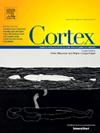通过镜子感受触摸:视觉和身体所有权在产生非真实触觉体验中的作用
IF 3.3
2区 心理学
Q1 BEHAVIORAL SCIENCES
引用次数: 0
摘要
触觉体验可以是非真实的,即与身体的实际刺激无关。最近,我们在健康受试者中使用镜盒程序,我们发现在双侧不对称触摸时,被刺激的右手的视觉,反射在镜子中,在真正的左手上引起了被触摸到与右手相同位置的感觉。因为这些错误类似于同步性,我们把这些错误的感觉称为“同步性错误”(SEs)。在这里,我们研究了自上而下的身体所有权感(BO)对镜像手的作用——使用显性(BO问卷)和隐性(皮肤电活动)测量BO和自下而上的视觉处理——通过操纵视觉反馈的存在/缺失——在触觉象限刺激测试(TQS)中产生se。在TQS中,受试者必须在三种情况下指出触觉刺激的位置,触觉刺激被施加在双手背部的不对称象限上:基线(无视觉)、镜像条件视觉(MCV);完全视觉反馈)和镜像条件盲(MCB;视觉反馈被遮挡)。我们测试了35个健康人。首先,BO的测量表明,大多数被试感觉右手被反射的手是他们自己的左手。此外,我们在MCV中发现了显著的se存在。最重要的是,与基线和MCB相比,MCV中左手的se显著更高,证实了视觉在诱导非真实触觉体验中的关键作用。此外,SEs与身体所有权测量之间缺乏相关性,两者之间存在双重分离,表明SEs是由视觉驱动的,而不是由BO的改变驱动的。本文章由计算机程序翻译,如有差异,请以英文原文为准。
Feeling touch through a mirror: The role of vision and body ownership in generating non-veridical tactile experiences
Tactile experience can be non-veridical, i.e., not related to the actual stimulation of one's body. Recently, using a mirror box procedure in healthy subjects, we found that during bilateral asymmetrical touches, the vision of the right-hand being stimulated, reflected in the mirror, elicited on the real left-hand the feeling of being touched in the same position as the right-hand. Because these errors resemble synchiria, we called these false feelings ‘synchiric errors' (SEs). Here, we investigated both the role of top-down feeling of body ownership (BO) over the mirrored hand—using explicit (BO questionnaires) and implicit (Electrodermal Activity) measures of BO- and bottom-up visual processing—by manipulating the presence/absence of visual feedback—in generating SEs during the Tactile Quadrant Stimulation Test (TQS). In TQS, subjects had to indicate the position of a tactile stimulus, applied in asymmetrical quadrants on the dorsum of the two hands, under three conditions: Baseline (no vision), Mirror Condition Vision (MCV; full visual feedback), and Mirror Condition Blind (MCB; visual feedback occluded). We tested 35 healthy individuals. First, measures of BO indicated that most subjects felt the right reflected hand as their own left hand. Moreover, we found a significant presence of SEs in the MCV. Crucially, SEs were significantly higher for the left hand in MCV compared to Baseline and MCB, confirming the critical role of vision in inducing the non-veridical tactile experience. Moreover, the absence of a correlation between SEs and body ownership measures, and a double dissociation between them, indicate that SEs are driven by vision and not by an alteration of BO.
求助全文
通过发布文献求助,成功后即可免费获取论文全文。
去求助
来源期刊

Cortex
医学-行为科学
CiteScore
7.00
自引率
5.60%
发文量
250
审稿时长
74 days
期刊介绍:
CORTEX is an international journal devoted to the study of cognition and of the relationship between the nervous system and mental processes, particularly as these are reflected in the behaviour of patients with acquired brain lesions, normal volunteers, children with typical and atypical development, and in the activation of brain regions and systems as recorded by functional neuroimaging techniques. It was founded in 1964 by Ennio De Renzi.
 求助内容:
求助内容: 应助结果提醒方式:
应助结果提醒方式:


